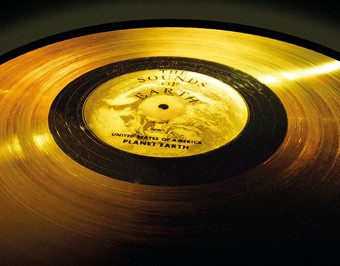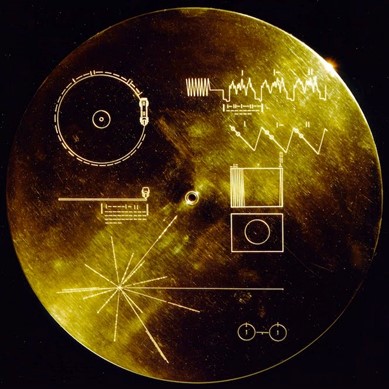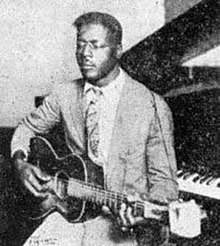The Golden Record:
December 18, 2021

The History of Human Existence Fits on Two Vinyls: The Sounds of Earth
By: Allie Little
What happens to our legacy as a species, when there are no humans left to share with or no Earth left to live on? To avoid this possible future, and ensure the preservation of the human species, a team of astronomers and scientists created a project that, if successful, would translate the human experience to any intelligent lifeform in the universe. The goal of this project was to fit the entire human experience on two phonographic records. Sounds easy right?
In 1977, NASA assembled a committee, led by Carl Sagan of Cornell University, with one mission: to decide what would be included on the Voyager Golden Records. This task would ask for the definition of humanity and the human experience. Before the team tackled that daunting question, they had to figure out some logistics.
How do you explain how to play the records themselves?
More specifically, how do you explain to a lifeform with no prior knowledge of Earth or human existence how to play a phonograph record? Assuming that math and science were universal truths in all the universe, they created this front side of one of the record to be their instructions:

For more info about each section check out this interactive picture!
Wait, did you say pictures?
The Golden Records have data for 115 images that the team decided represented the human experience. These images include pictures depicting animals, nature, anatomy, architecture, families, and something as plain as people eating and drinking. These pictures are contained in this purely auditory medium and represented in something we would affectionately describe as ‘noise.’ The specific collection of static, beeps, and boops (when put in an equation that is listed on the front of the record) generates each image. You can check out this video to see all 116 images selected by Carl Sagan’s team.
What sounds are on the Golden Records?
Along with the previously mentioned formulas, codes, and pictures, this record also had a collection of sounds and music etched onto the side labeled ‘Sounds of Earth’
These sounds of Earth included greetings in 55 languages, various sounds found in nature -- rain, storms, birds, whales, etc. -- and also a collection of music that the team thought represented the human experience. Taking influence from multiple different cultures, they selected traditional folk songs, classical music, and a small selection of more modern, popular music to carve into immortality. Of the 90 minutes of music selected for the record, here are some selections that might be familiar:
- ‘Brandenburg Concerto’ by Johannes Bach
- ‘Rite of Spring’ by Igor Stravinsky
- Ludwig van Beethoven’s ‘Fifth Symphony’
- ‘The Magic Flute, Queen of the Night’ aria by Wolfgang Amadeus Mozart
- ‘Melancholy Blues’ performed by Louis Armstrong
- ‘Johnny B. Goode’ by Chuck Berry*
*This spot was going to be filled by ‘Here Comes the Sun’ by The Beatles, but their record label EMI, who owned their master recordings, refused the offer. Because of EMI’s refusal, The Beatles missed their chance for their music to live on forever in the unknown reaches of the universe.
Apparently, many people told Sagan that Rock ‘n’ roll was too young of a genre to include on the record, and his response was, ‘there’s a lot of young people on the planet.’ Music was also pulled from Peru, China, Mexico, Australia, New Guinea, Japan, Bulgaria, India, and various Native American tribes.
Another song that was selected by astronomer Timothy Ferris was ‘Dark was the Night, Cold was the Ground’ by Blind Willie Johnson. If you grant me the pleasure of being slightly hyperbolic, this song illustrates how music creates connections between all humans and could even hold the key of explaining our culture to an alien lifeform.
According to Timothy Ferris, the song reflects an ‘eternal part of the human experience: nightfall with no place to sleep.’ The 3 minute and 20 second song is not the only song selected that lacks words, but it is the only song selected that substitutes those words for groans and moans. This quality allows for the song to express longing and sadness in a way that is rarely portrayed but universally understood.

Blind Willie Johnson’s life is known mostly through legends. There is only one picture of the man in existence, and he only recorded 30 songs in his life. Born in Texas in 1897, Johnson wanted to be a preacher and sing words of faith and inspiration. An unfortunate accident, supposedly at the hands of his stepmother, left a 7-year-old Willie blind and brought along his nickname of ‘Blind Willie Johnson.’ He spent most of his time playing guitar on the streets with a cup tied around his neck and perfecting a slide technique using a pocket knife, which is the technique heard on the recording of ‘Dark was the Night, Cold was the Ground.’ He immortalized his playing and talent in only 30 recorded songs.
At the age of 48, his house in Texas burned down. Legend has it that he laid overnight on the burnt, wet ground of his former home, eventually dying of pneumonia.Truly a tragic end to the equally difficult life of Blind Willie Johnson.
His music now soars through the universe, reaching places he and no one else will ever see. The selection of his song for the Voyager Golden Records exemplifies the universal connection of all humans, no matter the geographic, cultural, economic, racial, or any other made up barrier we’ve created to keep us apart. We all suffer through pain and loss. We are all inspired by stories of redemption and triumph. And, eventually, we all end up in a night that’s too dark and a ground that’s too cold.
The creation of the Golden Records speaks more to the human experience than any images, sounds, or songs ever could. As humans, we desire to be remembered, to document and solidify our existence in a way that lets us live on after we die. How human of us to spend so much time on trying to summarize every experience of our society on two vinyl records.
Instead of asking our staff at the museum to summarize all of human existence in 27 songs like the team of the Golden Record did, I asked them all to give me five songs they would use to describe themselves to an alien lifeform. So, enjoy this expansive collection of songs hand-picked by our Museum of World Treasures crew!
The Crew:
DECKARD -
- Human Music by Ryan Eldar
- Spanish Flea by Herb Albert
- Covenant Dance by Martin O’Donnell
- Wormmaster by Duncan Trussell
- Little Black Train by Woody Guthrie
ALLIE -
- Jolene by Dolly Parton
- Never Grow Up by Taylor Swift
- Scarborough Fair/Canticle by Simon and Garfunkel
- Lullabye by Billy Joel
- Killing Me Softly by Fugees
JORDAN -
- Rocky Mountain High by John Denver
- My Wish by Rascal Flatts
- 12 Years Later from the Treasure Planet Soundtrack
- Concerning Hobbits from the LOTR SOT
- Highland Cathedral
KAYSEY-
- ME! By Taylor Swift
- Buttload of Cats by Rachel Bloom
- 30/90 by Jonathon Larson
- Grigio Girls by Lady Gaga
- We Didn’t Start the Fire by Billy Joel
KRISTIN-
- Somebody to Love by Queen
- Something to be Proud of by Montgomery Gentry
- Nocturne in C# minor by Chopin
- Livin’ on a Prayer by Bon Jovi
- All Creatures of our God and King
ALAN -
- Overthinker by IN20
- Funk Jesus by The Floozies
- Loving is Easy by Rex Orange County
- BRNT by Magic City Hippies
- Harmony by GRiZ
DANIELLE -
- Feeling Good by Michael Buble
- Dog & Butterfly by Heart
- Black Horse and a Cherry Tree by KT Tunstall
- Diamonds are a Girl’s Best Friend by Marilyn Monroe
- Moon River by Audrey Hepburn
BRAD -
- Peace of Mind by Boston
- Raise Your Glass by P!nk
- Still Haven’t Found What I’m Looking For by U2
- Carry On My Wayward Son by Kansas
- Fooling Yourself by Styx